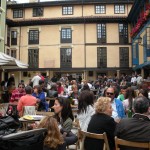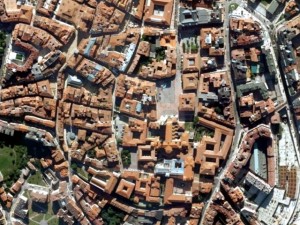by Connor Martin, Portland State University
Oviedo carries its tradition and history by taking pride in its beautiful intact medieval old town, where cars are prohibited and people walk in safety. Even though a serious fire destroyed many parts of the original town in 1521, during this time the boundaries of the city were defined and the walls were constructed; parts of the remaining wall are incorporated into the medieval quarter today. The  medieval quarter maintains the historic ambiance with the Gothic cathedral, civic buildings, open plazas, and many cafes and bars. As a result, the history is represented through the buildings, atmosphere, and culture of the people actively living there today.
medieval quarter maintains the historic ambiance with the Gothic cathedral, civic buildings, open plazas, and many cafes and bars. As a result, the history is represented through the buildings, atmosphere, and culture of the people actively living there today.
The location that I feel best represents the center of Oviedois the plaza in front of the cathedral. The plaza is so large that it provides a unique feeling of  openness in the center of the city. “La Gorda”, a Madonna and child statue by the artist Botero, next to parque San Francisco in the Plaza Escandelera may be the social meeting point for Oviedo, but the soul of Oviedo is the cathedral. Pastry shops, cider bars, restaurants and cafes surround the cathedral, and what better object of triangulation could one ask for than the historic and architectural complexity and visual elegance of the Cathedral! The city of Oviedo was originally built with the cathedral as the focal point of the town, and in that respect it remains true to its heart to this day.
openness in the center of the city. “La Gorda”, a Madonna and child statue by the artist Botero, next to parque San Francisco in the Plaza Escandelera may be the social meeting point for Oviedo, but the soul of Oviedo is the cathedral. Pastry shops, cider bars, restaurants and cafes surround the cathedral, and what better object of triangulation could one ask for than the historic and architectural complexity and visual elegance of the Cathedral! The city of Oviedo was originally built with the cathedral as the focal point of the town, and in that respect it remains true to its heart to this day.
Surrounding the Cathedral is the old quarter of Oviedo: buildings of past and present, all of which are built almost entirely out of stone. Outside of the Cathedral and plaza, there are fou r other plazas of varying sizes, two large churches, an indoor food market, and innumerable mixed use housing units; all designed and built in a very eclectic, and thoroughly European, fashion. But the sheer age and beauty of diversity is not exactly what should be praised, it’s the intrinsic value that is worth acknowledging. The idea of preserving the past while building and improving around it is a common theme in European cities, while it seems that in America, we tend to build for the short term. When coming to Oviedo, it is not just the Medieval wall in the Plaza de Riego that makes you feel that you are in a different place than America, or the toweri
r other plazas of varying sizes, two large churches, an indoor food market, and innumerable mixed use housing units; all designed and built in a very eclectic, and thoroughly European, fashion. But the sheer age and beauty of diversity is not exactly what should be praised, it’s the intrinsic value that is worth acknowledging. The idea of preserving the past while building and improving around it is a common theme in European cities, while it seems that in America, we tend to build for the short term. When coming to Oviedo, it is not just the Medieval wall in the Plaza de Riego that makes you feel that you are in a different place than America, or the toweri ng Gothic Cathedral, it’s the cultural idea that begot the preservation of these buildings, because that same idea slowly created the city around us. Just as a coral reef is built of the shadows and skeletons of the everyday lives of living things, the European city is built with and around the human lives of yesteryear; slowly and surely building a diversity of forms and styles on top of each other, supporting each other in their everyday creation– that is the city.
ng Gothic Cathedral, it’s the cultural idea that begot the preservation of these buildings, because that same idea slowly created the city around us. Just as a coral reef is built of the shadows and skeletons of the everyday lives of living things, the European city is built with and around the human lives of yesteryear; slowly and surely building a diversity of forms and styles on top of each other, supporting each other in their everyday creation– that is the city.
During the daylight hours many elderly couples can be seen walking the streets, clad in fur coats and tall hats, mostly sticking to drinking coffee  and socializing with their peers, of which there are many. All of these demographics, young children and their parents, teenagers and elderly people all have roles to play in the same area. This is what makes the old town inOviedoso unique– each different group of its citizens coexisting harmoniously, taking ownership of the public places together.
and socializing with their peers, of which there are many. All of these demographics, young children and their parents, teenagers and elderly people all have roles to play in the same area. This is what makes the old town inOviedoso unique– each different group of its citizens coexisting harmoniously, taking ownership of the public places together.
It is my belief that the old quarter contributes greatly to the feelings of wellbeing in the city of Oviedo. There’s something about engagement in social activities that helps reduce the sense of isolation and purposelessness that can develop in people. And the old town not only provides opportunities for social interaction, it practically forces it upon you! In its own way, the old town in Oviedo creates a feeling of wholeness and connection that can’t quite be replicated through other means, and through this makes a positive impact on every citizen living in or visiting Oviedo.

